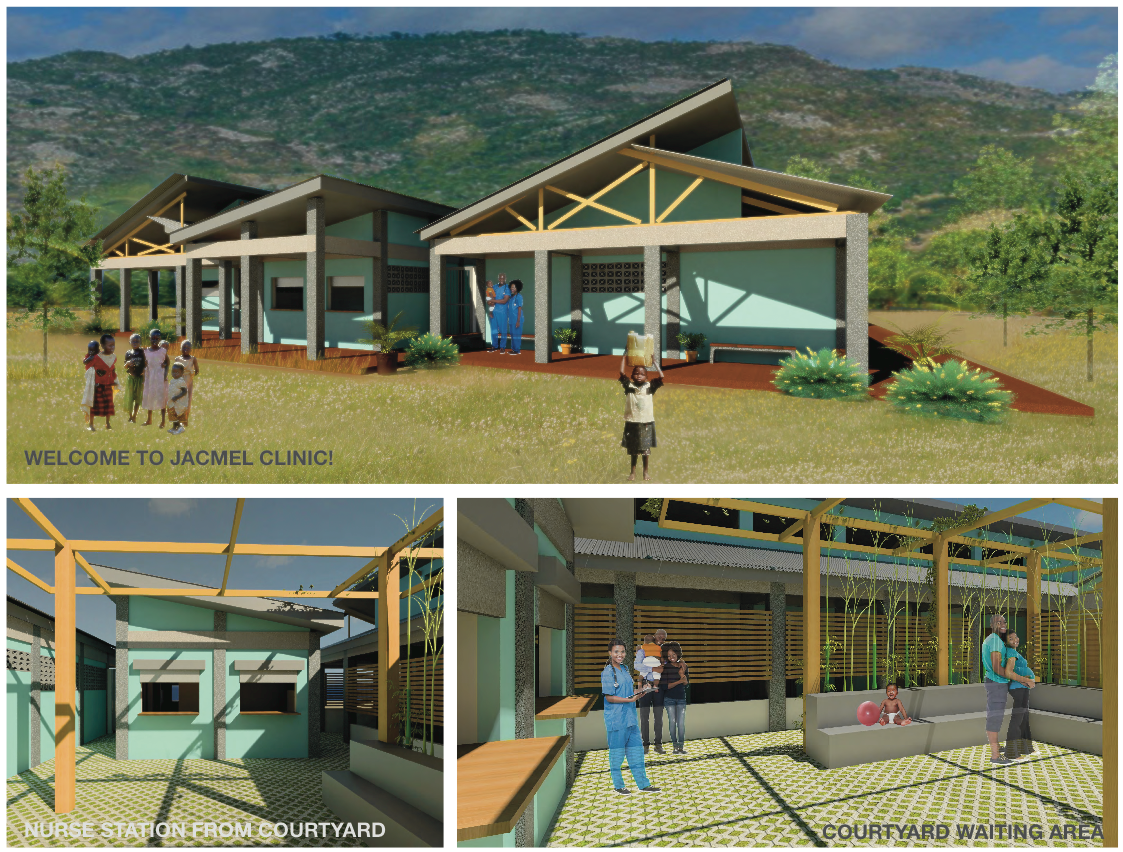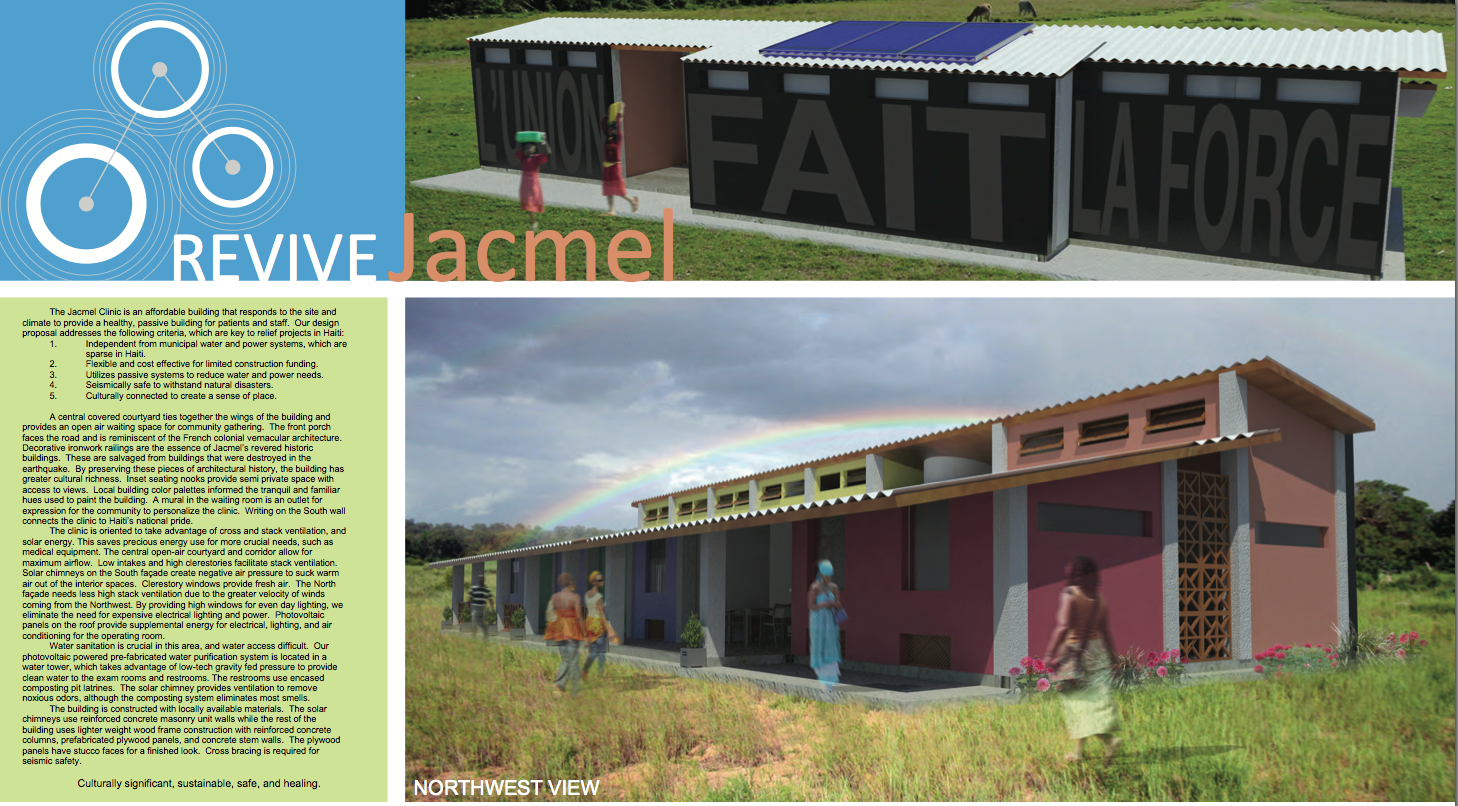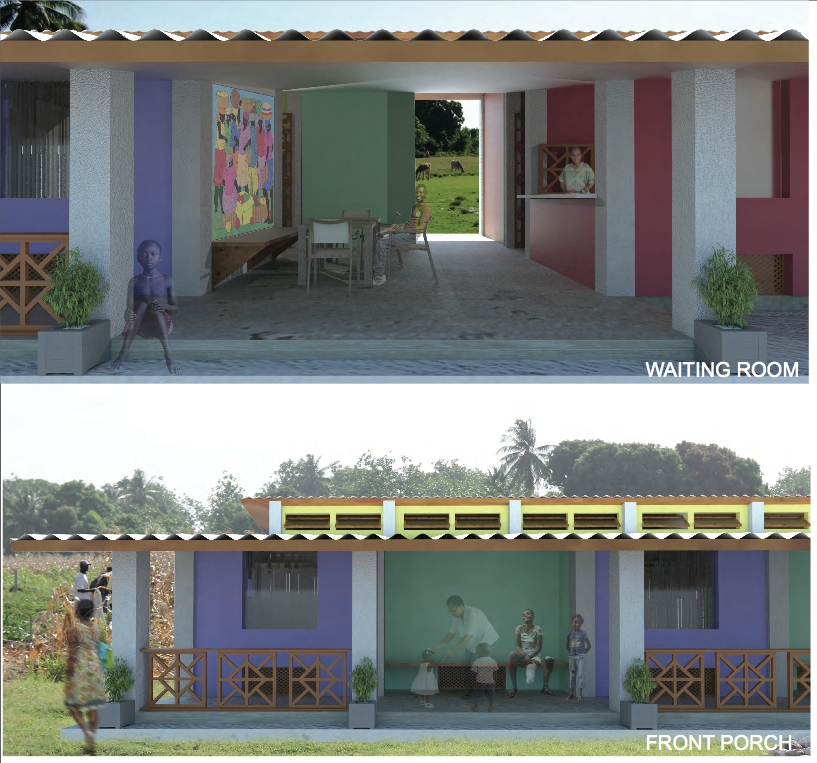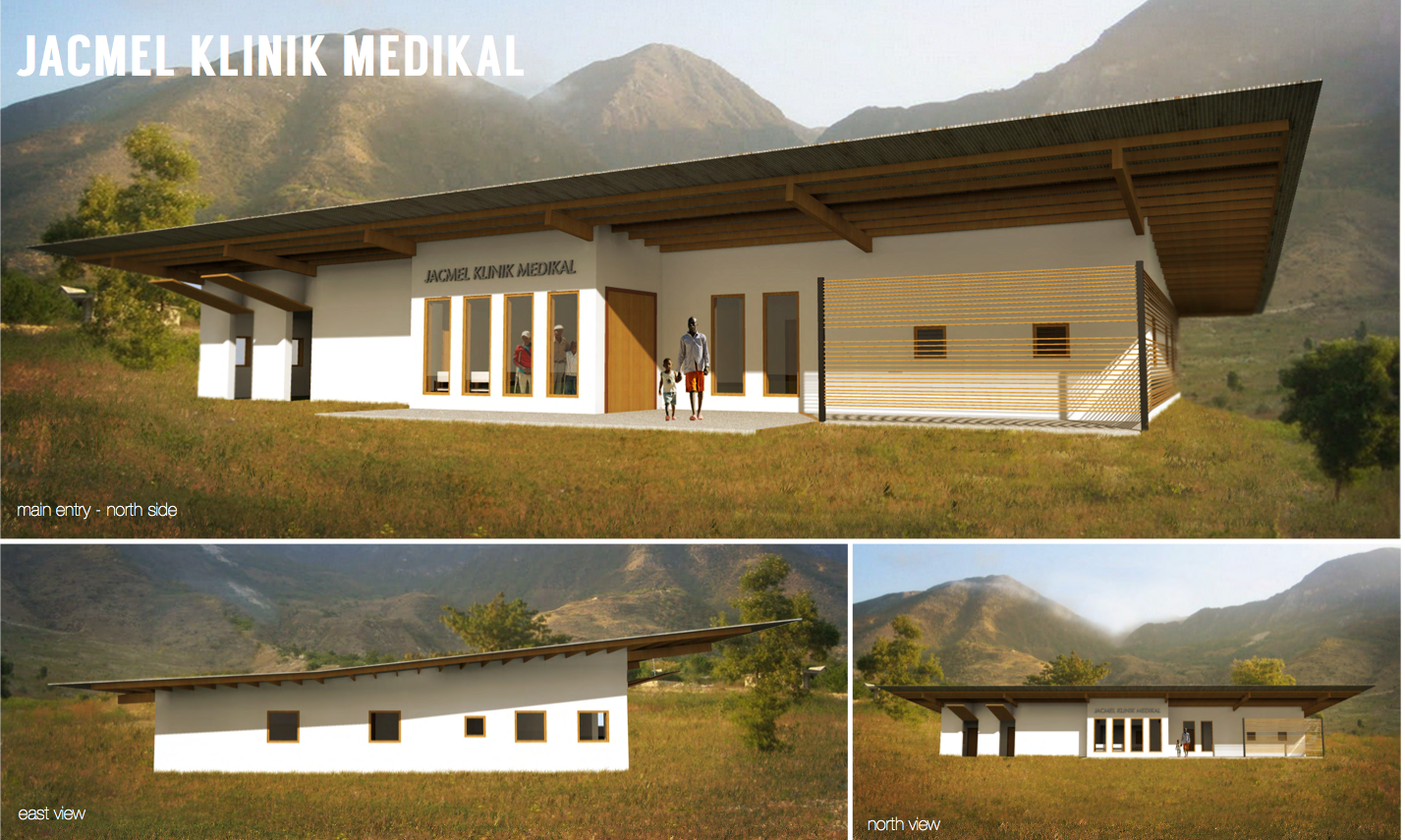
UO Architecture Students Design for Haitian Healthcare Clinic REvive Jacmel
Students collaborate with professionals on an interdisciplinary, student-led project to create a new healthcare clinic in Jacmel, Haiti.
This summer 2013 REvive Jacmel, an inderdisciplinary student-led project to create a new healthcare clinic in Jacmel, Haiti, held a competition and subsequent awards reception at the University of Oregon in Portland School of Architecture and Allied Arts.
With guidance from Waterleaf Architecture, UO in Portland Department of Architecture students Annie Ledbury and Beth Lavelle organized and coordinated the REvive Jacmel charrette and competition to develop a design for a small general healthcare clinic to be built in the Haitian city of Jacmel, a town continuing to recover from the 2010 earthquake. With direction from Nancy Cheng, UO in Portland Architecture Program director and associate professor, Ledbury and Lavelle, along with UO student Rachel Peterson as research assistant, worked with the project’s instigator, Dr. Michael Workman, a Portland-Vancouver based plastic surgeon.

Workman, Ledbury and Lavelle organized students from UO, the University of Portland and Oregon State University to work collaboratively on the design. Workman is part of RestoreHaiti, a group dedicated to improving healthcare conditions in Haiti. The REvive Jacmel project began as an addition to Workman’s efforts to organize “monthly health care teams [to] bring much needed medicine and staffing to local medical clinics” to improve health care in the region.
On his many volunteer trips to Haiti to administer healthcare, Workman saw the lack of modern medical facilities. He recognized a need for a clinic that could perform dental procedures and major surgeries using general anesthesia . The clinic would have to be approximately 2,500 square feet, fully functional off-grid with only generators for electricity, and otherwise operable with little access to utilities and modern conveniences. It would need to be built by local residents with their knowledge of and ability to construct using local materials and minimal direction.

The idea for the project began when Dale Campbell, member of the Associated General Contractors of America, connected Workman to Waterleaf Architecture’s Dick Aanderud. Workman approached Waterleaf Architecture to see if the firm was interested in partnering in the project. Wanting to integrate students from local universities, Workman reached out to engineering students at the University of Portland and to construction management students at OSU. Waterleaf’s Dick Aanderud (UO architecture alumnus) and Emily Refi (UO architecture alumna and adjunct instructor) felt UO architecture students should be involved as well. Aanderud and Refi approached UO’s Nancy Cheng. Emily Refi explains, “It turned out Dr. Workman and UO felt strongly about having a competition, and the idea to make it interdisciplinary with engineering and construction students teamed with architectural students— just like in the real world—emerged.”
University students in the REvive competition worked with architects at Waterleaf Architecture and engineers at KPFF Consulting Engineers, who are also involved in the project, to further develop their concepts with expert guidance.


At the September 5 competition awards reception held at the University of Oregon in Portland School of Architecture and Allied Arts, the student teams presented their entries in the REvive competition.
The four student teams were comprised of:
Team 50010:
Melissa March – UO Architecture
Rachel Peterson – UO Architecture
Scott Soukup – UO Architecture
Erik Sasovetz – Residency Physician, Peach Health Southwest Medical Center
Andrew Riley – OSU Construction Management
Sarah Cochenour – OSU Construction Management
Team 50030:
Grace Aaraj – UO Architecture
Jackie Davis – UO Architecture
Matt Deraspe – UO Architecture
Team 50040:
Adam Lawler – UO Architecture
Tim Niou – UO Architecture
Daniel Freitas – OSU Construction Management
Team 50050:
Eli Rosenwasser – UO Architecture
Sermin Yesilada – UO Architecture
Mary Kate Cullinane – UP Engineering
Jeff Nakashima – OSU Construction Management
Brady Webster – OSU Construction Management

After the jury members deliberated and the assembled crowd had a chance to vote for People’s Choice, the team awarded Best Overall, Most Constructable Scheme and People’s Choice, was Grace Aaraj, Jackie Davis, and Matt Deraspe—all University of Oregon students.

Commenting on the projects, Workman noted that he was “amazed at both the quality of work-product and flawless follow-thru by all the students. If this is what the next generation has to offer we are indeed in good hands.”

Discussing her team’s winning concept and collaboration, Jackie Davis said,
I am thrilled to be working on the Haiti project with such a great team. Having both enthusiastic students and professional advisers in all the fields working together on the project is making for a very exciting learning experience.
From the designs submitted by each team, the best ideas will be further examined and selected by competition jurors and will be translated into construction documents in fall 2013 by students who will work closely with Waterleaf Architecture and KPFF. Construction is tentatively scheduled to begin in December 2013. Students Grace Aaraj, Jackie Davis and Annie Ledbury are confirmed to be contining with the project as it continues under the direction of Waterleaf Architects this fall and winter (2013-2014).
Davis continued saying,
Having our design chosen to get built was fulfilling in and of itself, but to now getting to see it through to the finish is an opportunity unlike any other in graduate school. It’ll be a steep learning curve with the tight schedule but I’m so happy to see things making progress for this great cause.
Davis’ team partner, Grace Aaraj was enthusiastic to point out the vast scope of the collaboration and the humanitarian goals of the project:
For the winning design, it is like a dream coming true: to be able to design a building, win a competition and then join a firm with a lot of professionals to help you develop it further and make it come to life.
On a similar note, it means a lot to me to be part of this project since it targets directly a daily life and real situation problem. In my conviction, architecture like any other art or science (in fact, architecture is a symbiosis of both) should serve people. It was a fresh experience to stay away from any autobiographical move in the project, go back to basics and use the same language ( materials, needs, colors, traditions) of the locals in Jacmel. I hope the project will be really built, and I will be able to see it one day, and maybe volunteer in Jacmel as well.
The partners in the REvive Jacmel project include Workman, UO in Portland Department of Architecture, University of Portland Shiley School of Engineering, Oregon State University School of Civil and Construction Engineering Construction Engineering Management, Waterleaf Architecture, KPFF Consulting Engineers and the Associated General Contractors of America (AGC) Oregon Columbia Chapter.
Workman, who deserves significant credit for a large part of the success of this project, remarked after the review process that the “collaboration between OSU, UO, UP and architectural/ engineering professionals [was] excellent.” Workman further noted that “The creative idea’s generated by all 4 teams was extremely impressive. They were able to both think outside the box, and to deal with the multiple issues involved in building a medical clinic in a third world setting.”
Competition Jurors include:
Yashar Hanstad, architect, TYIN Architects, Norway
Lisa Lutton Majchrzak, architect, BAR Architects, San Francisco
Craig Totten, structural engineer, KPFF Consulting Engineers
Brian Cavanaugh, architect, Architecture Building Culture
Sergio Palleroni, fellow at Portland State University, director of the BaSIC Initiative
Steve Malany, president of P&C Construction and incoming AGC president
Links:
- Haiticlinicpdx.wordpress.com
- Facebook group REvive Jacmel,
- http://haiticlinicpdx.wordpress.com/
The following are comments from Grace Aaraj, who writes from a personal perspective on the project and the process, on the logistics between collaborating between time zones in her homeland of Beirut and Portland, bridging cultural understandings and asking the right questions…
I think the most important thing I learnt is how to design this real project, for real people in time of crisis. In architecture school we are usually limited to site constraints or specific clients’ needs provided to us through discussions with professors and students.
In Jacmel’s case, we knew so little about the site and the people. Google earth didn’t help so we extended our research to documentaries, talking to people and a kind of “role player” where we almost close our eyes and imagine to be a citizen there:
What will we need?
What would make us feel safe and cared for?
What is life like before the earthquake? How is life after it?
It was more like a recipe where we must fulfill functional requirements, and be “limited” to the local materials and craftsmanship. Towards the end we learned that we were not “limited” by these factors, rather INSPIRED: this is when Jackie, my teammate and I, were able to liberate our design and include interactive community spaces, shaded outdoors and backyard (etc…) using only local resources. We used the site disadvantage to create a prototype that could be adapted to sites with different slopes or orientation, not only for Jacmel, but possibly for other places.
We were very limited in time , Jackie and I, since I was in Tokyo for 2 weeks and then i came to Beirut and Dubai. So we managed to invest our time to the best use. We were very communicative and we tried forgetting about deadlines or stress. We would take walks, talk to people and watch documentaries.
All the decisions were taken before I came to Beirut. For the last week, we would work online and share files on Dropbox. It was very interesting to work with a 10 hours difference. It was also very rewarding to sleep, wake up and find the other person’s work on the shared folder. The synchronization was a big incentive for us to work.